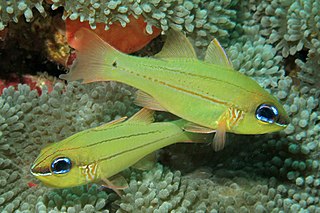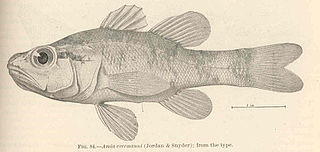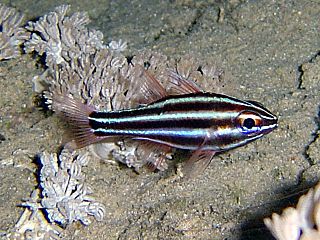
Gulf St Vincent, sometimes referred to as St Vincent Gulf, St Vincent's Gulf or Gulf of St Vincent, is the eastern of two large inlets of water on the southern coast of Australia, in the state of South Australia, the other being the larger Spencer Gulf, from which it is separated by Yorke Peninsula. On its eastern side the gulf is bordered by the Adelaide Plains and the Fleurieu Peninsula.

Ostorhinchus fleurieu is a species of cardinalfish native to the Red Sea and Persian Gulf, the Gulf of Oman, and the waters around East Africa, Seychelles, India, Sri Lanka, the Indo-Malayan region, and Hong Kong., south to the Ashmore Reef, Western Australia. It is the type species of the genus Ostorhinchus. The specific name honours the French explorer and hydrographer Charles Pierre Claret, comte de Fleurieu (1738-1810) who was a colleague and friend of Lacepède's.

Zoramia gilberti is a Cardinalfish from the Western Central Pacific. It occasionally makes its way into the aquarium trade. It grows to a size of 4.2 cm in length. It is found in sheltered bays and lagoons, where it gathers in large aggregations among branching corals, frequently mixed with other cardinalfish species. The specific name honours the American ichthyologist and fisheries biologist Charles H. Gilbert (1859-1928) of Stanford University who was a colleague of Jordan's.

Istiblennius is a genus of combtooth blennies found in the Pacific and Indian Oceans. The generic name is a compound noun composed of istio the Greek for "sail", referring to the high dorsal fin of the type species, Istiblennius muelleri, and blennius which is derived from a word for "mucus" and refers to the scaleless bodies that characterise the Blenniidae.

Hemiscyllium michaeli, the leopard epaulette shark, is a species of bamboo shark in the genus Hemiscyllium. It is a tropical shark known from the shallow ocean in the Milne Bay region of eastern Papua New Guinea. The epaulette sharks of this region have long been confused with H. freycineti, and it was only in 2010 that H. michaeli was described as a separate species by Gerald R. Allen and Christine L. Dudgeon. It can reach a maximum length of 69.5 centimetres (27.4 in).

Ostorhinchus sealei, Seale's cardinalfish or the cheek-barred cardinalfish, is a species of ray-finned fish, a cardinalfish, from the family Apogonidae. It is an Indo-Pacific species which ranges from Malaysia east to the Solomon Islands, north to southern Japan and south to northwestern Australia, as well as Palau in Micronesia. It is an uncommon species which occurs among branching corals in the sheltered lagoons protected by reefs. It can be found in small to large aggregations low in the water over the reef. It is infrequent below depths of 10 metres (33 ft). They are mouthbrooders which form pairs to mate. During the day these fish shelter in the reef and they emerge at night to feed on zooplankton and benthic invertebrates. The specific name honours the American ichthyologist Alvin Seale (1871-1958).

Cercamia is a genus of fishes in the family Apogonidae, the cardinalfishes. They are native to the Pacific and Indian Oceans.

Fowleria is a genus of fishes in the family Apogonidae native to the Indian and Pacific Oceans. The name of this genus honors the American ichthyologist Henry Weed Fowler ( ) of the Academy of Natural Sciences of Philadelphia, who attended Stanford University, where he was a student of David Starr Jordan's.

Gymnapogon is a genus of fish in the family Apogonidae. They are native to the Indo-West Pacific and central Pacific Oceans, where they occur in reefs and nearby habitat types. These species are usually no more than 5 centimeters long and have semitransparent bodies without scales. The genus name is a compound noun formed by combining the Greek gymnos meaning "naked", referring to the lack of scales in the type species, Gymnapogon japonicus, and Apogon, the type genus of the Apogonidae. One species, the B-spot cardinalfish, is notable for its larvae being rather large, conspicuous and fast-swimming.
Lachneratus phasmaticus, also known as the phantom cardinalfish, is a species of fish in the family Apogonidae, the cardinalfishes. It is the only member of its genus. It is native to the tropical eastern Pacific and Indian Oceans. This fish can be found in crevices and underwater caves, and it occurs at depths of 3 to 104 m. It grows to a standard length of 7.4 cm (2.9 in).
Paxton concilians, also known as the Paxton's cardinalfish, is a species of cardinalfish native to the Indian Ocean waters off of western Australia where it is found over the continental shelf at depths of from 46 to 80 metres. This species grows to a length of 7.6 centimetres (3.0 in) SL. This species was previously classified as the only known member of its genus and of its subfamily but the 5th edition of Fishes of the World placed the genus in the subfamily Pseudaminae. The genus name honours the Australian zoologist John R. Paxton of the Australian Museum in Sydney who provided the describers with the type specimens while the specific name means the uniting of disparate parts into a whole, a reference to this species continuous dorsal fin.

Zapogon evermanni, Evermann's cardinalfish, is a species of cardinalfish native to tropical reefs in the Indian and Pacific Oceans and the western Atlantic Ocean.

Caesio is a genus of marine ray-finned fish, fusiliers belonging to the family Caesionidae. They are native to the Indian Ocean and the western Pacific Ocean, although one species has invaded the eastern Mediterranean Sea through the Suez Canal by Lessepsian migration.
Gerald Robert "Gerry" Allen is an American-born Australian ichthyologist. His career began in 1963, when he spent a semester at the University of Hawaii, where he also received a PhD in marine zoology in 1971. In 1972, Allen wrote his doctoral thesis on the systematics and biology of the anemone fish.

Ostorhinchus cookii, common names Cook's cardinalfish, Cook's soldierfish, blackbanded cardinal, blackbanded cardinalfish, is a species of marine fish in the family Apogonidae.

Ostorhinchus capricornis, also known as the Capricorn cardinalfish, is a species of ray-finned fish, a cardinalfish from the family Apogonidae which occurs around reefs in the western Pacific Ocean.

Ostorhinchus doederleini is a species of fish in the cardinalfish family, also known by the common names Doederlein's cardinalfish and fourline cardinalfish. In Japanese it is called osuji-ishimochi. It is native to subtropical regions of the western Pacific Ocean, its distribution extending from Japan to Taiwan and Australia to New Caledonia and the Kermadec Islands.
Pseudamia hayashii, commonly known as Hayashi's cardinalfish, is a species of cardinalfish native to the Indian and Pacific Oceans frpm the Gulf of Aden to Samoa, north to southern Japan and south to Western Australia. The specific name honours the Japanese ichthyologist Masayoshi Hayashi, a curator at the Yokosuka City Museum, who has studied the cardinalfishes of Japan and who lent a specimen of P. hayashi on learning of the authors' research on the genus Pseudamia.

Jaydia queketti, the spotfin cardinal or signal cardinalfish, is a species of ray-finned fish from the Indian Ocean, it is a member of the family Apogonidae. It has colonised the eastern Mediterranean Sea by way of the Suez Canal since 2004.

Jaydia smithi, Smith's cardinalfish, is a species of ray-finned fish from the Indian and Pacific Oceans, a member of the family Apogonidae. It has colonised the eastern Mediterranean Sea by way of the Suez Canal since 2007.
















